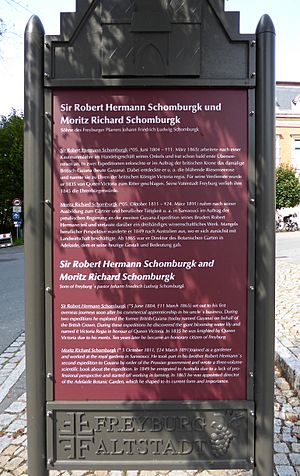Robert Hermann Schomburgk facts for kids
Quick facts for kids
Robert Hermann Schomburgk
|
|
|---|---|
 |
|
| Born | 5 June 1804 Freyburg |
| Died | 11 March 1865 Schöneberg |
| Occupation | Diplomat, world traveler, illustrator, merchant, writer |
| Awards |
|
Sir Robert Hermann Schomburgk (born June 5, 1804, died March 11, 1865) was an amazing explorer from Germany who worked for Great Britain. He traveled a lot, studying geography, people, and plants in South America and the West Indies. He also worked as a diplomat for the United Kingdom in countries like the Dominican Republic and Thailand.
Contents
Robert Schomburgk: Explorer and Diplomat
Early Life and Adventures
Robert Schomburgk was born in Freyburg, Germany. His father was a Protestant minister. When Robert was 16, he learned about botany (the study of plants) from a professor while staying with his uncle.
He first tried a career in business. In 1828, he moved to the United States. He worked in cities like Boston and Philadelphia. He even helped transport sheep to Virginia. Later, he became a partner in a tobacco factory in Richmond, Virginia. Sadly, the factory burned down, and he lost everything. He faced more bad luck on the Caribbean island of St. Thomas, where another fire destroyed his belongings. After these tough experiences, he decided to stop his business ventures.
Exploring South America
In 1830, Schomburgk went to Anegada, one of the British Virgin Islands. This island was known for many shipwrecks. Even without special training, he surveyed the island on his own. He sent a report to the Royal Geographical Society in London. They were so impressed that in 1835, they asked him to lead an expedition to explore British Guiana (now Guyana).
He did a fantastic job on this mission from 1835 to 1839. During this time, he made an exciting discovery: the giant Victoria Regia water lily in 1837! He also found many new types of orchids. One group of orchids, Schomburgkia, was even named after him. He also helped clear up an old myth about Lake Parime. People used to believe this was a huge lake of gold. Schomburgk showed that it was actually the Rupununi savannah that flooded during certain seasons, making it look like a lake.
In 1841, he returned to Guiana. This time, he was an official for the British Government. His job was to survey the colony and mark its borders. This led to the "Schomburgk Line", which was a temporary border between British Guiana and Venezuela. He also helped define the border with the Dutch colony of Surinam.
He continued to study the geography and the local people. His brother, Moritz Richard, joined him there. Robert Schomburgk strongly believed that the border with Brazil needed to be fixed. He was concerned about the well-being of local communities. His surveys later helped decide the southern border between British Guiana and Brazil. The King of Italy made the final decision in 1904.
When the brothers returned to London in June 1844, Schomburgk shared his journey report with the Geographical Society. For his great work, Queen Victoria made him a knight in 1845. He continued to work in important roles. In 1846, he was in Barbados. He collected information to write a detailed book about the island, which was published in 1848 as History of Barbados.
Diplomatic Missions
In 1848, he became the British consul to the Dominican Republic. A consul is like a representative for their country in another country. In 1850, he helped Great Britain sign a good trade agreement. He also helped the Dominican government get a truce (a temporary stop to fighting) from Soulouque.
In the years that followed, he wrote important papers about the geography of the island for the Royal Geographical Society. He was the first person known to climb Pico Duarte in 1851. This is the highest mountain in Hispaniola (the island shared by the Dominican Republic and Haiti) and the entire Caribbean! He named it "Monte Tina" and almost correctly measured its height at 3,140 meters (about 10,300 feet).
In 1857, he was promoted to British Consul-General of Siam (as Thailand was then known). He was based in Bangkok and continued his geographical surveys. He even visited the semi-independent kingdom of Chiang Mai in 1859–60. From there, he traveled by elephant across mountains to Moulmein in Myanmar. This amazing trip lasted 135 days and covered about 1,000 miles!
Later Life and Recognition
Schomburgk retired from public service in 1864 because of health problems. He passed away in Schöneberg on March 11, 1865.
Robert Schomburgk was a member of many important scientific groups in Europe, America, and Asia. He received special honors, including being a knight of the Legion of Honour and the Prussian Order of the Red Eagle.
Many plants and animals were named after him to honor his discoveries:
- The Schomburgk's deer (Rucervus schomburgki) was named in his honor.
- Several South American fish species bear his name, such as Mylesinus schomburgkii, Polycentrus schomburgkii, and Myloplus schomburgkii.
- Many plants from the Neotropics (tropical parts of the Americas) are also named for him, like Harperocallis schomburgkiana.
His collection of plants is kept at the Royal Botanic Gardens, Kew in England. His collection of items from the local people of Guyana is at the British Museum.
Robert Schomburgk's Writings
Robert Schomburgk wrote several books and reports about his travels and discoveries. These works helped people learn more about the places he explored. Some of his important writings include:
- Voyage in Guiana and upon the Shores of the Orinoco during the Years 1835–'39 (1840)
- Description of British Guiana, Geographical and Statistical (1840)
- History of Barbadoes (1847)
- The Discovery of the Empire of Guiana by Sir Walter Raleigh (1848)



